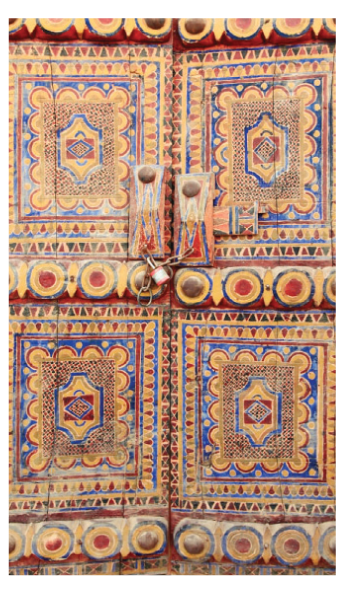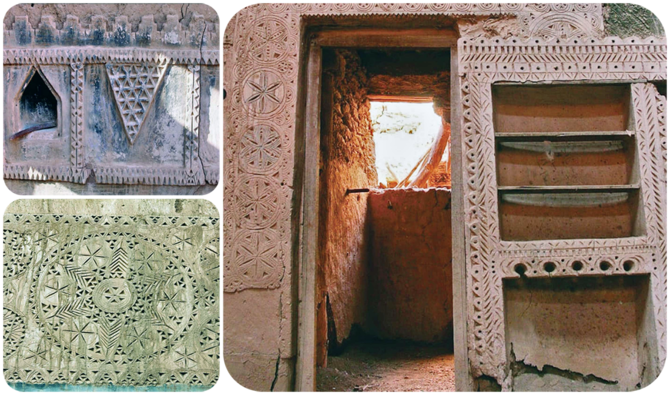MAKKAH: The old doors of Najd are known for their rich decoration. They are inspired by nature and represent the culture and deep roots of the central Saudi region. They were an essential part of family homes and a focal point for residents and their guests.
The decorations created by the people of Najd were inspired by the region’s plants and trees. They dyed them with the colors of acacia and its seeds, as well as pomegranate, to make them brighter.
This decor was a cultural treat for guests, who enjoyed the beauty of those doors, their engravings and colors.
Historian Mohammed Al-Suwaih said that Najdi decorations had been passed down from one generation to the next. “You find that the fathers and grandfathers were carpenters,” he told Arab News. “The builders also passed their profession down to the next generations.”
He said that Najdi decorations used to be inspired by the environment surrounding the community. The shapes were inspired by wild plants and flowers, palm fronds, as these were abundant, the sun and its rays, and mountains, which were depicted as triangles and carved onto the doors.
Some of the doors are lavishly and ornately decorated. These include the doors of the majlis (room to receive guests), main entrances, and the doors separating the majlis and the rest of the house.
Builders deployed their full artistic talents when working on the majlis as it was the cultural front that received guests. The more decorated the majlis, the wealthier and more influential the owner. There are not many decorated majlises, however.
Al-Suwaih said the average person had simple majlises that were built in the shape of a triangle as it was difficult for everyone to own lavish doors and majlises.
“There are over 30 types of decorated doors that differ according to the place. For example, Unaizah has its own identity, and so do Riyadh, Sudair, Buraidah, and the rest.”
HIGHLIGHTS
• The decorations created by the people of Najd were inspired by the region’s plants and trees.
• They dyed them with the colors of acacia and its seeds, as well as pomegranate, to make them brighter.
He explained that every city had a grand master who specialized in this art. Those who were acquainted with this art knew the cultural background of a door from the first time they looked at it. Such doors used to get traded and are still in demand to this day.
Al-Suwaih said that the person who decorated walls was different from the one who decorated the doors. “Each has his own method, style, and colors. The doors of Najd were distinguished from those of other Saudi cities in that they included decoration and engraving as well as colors, an aesthetic flair.”
The decoration of Najdi doors is known for the intersection of lines, inner rings, and triangles. The front door of a house includes its name, date, some expressions of praise, thanks to God, and prayers for Prophet Muhammad. The date would be added to the door and the majlis, and some of these still exist today.
Among the decorated doors were “kamer” doors that were built in the form of two small doors. Some of them are decorated on one side only, while others are decorated on both sides.
Similarly the door separating the house from the majlis had two panels, and it was usually decorated on both sides for residents as well as guests.
He explained that there were types of decoration that spread in Najd, including the “hadaire.” This design comprises triangles as ornaments placed on the house’s exterior in a circular shape covering the entire house. The tops of these triangles point down and contribute to the flow of the water in a streamlined manner so it does not affect the wall’s durability.
Another type of decoration is the “lahj,” which comprises triangles engraved in the walls to create windows that are arranged in a way that controls the entry of light and the exit of smoke when wood is burned for heating and cooking. These were also used for storage.
Al-Suwaih added that a builder would repeat the triangles, squares, and lines, and the circles would overlap until there was an aesthetic decoration. “The builders preferred plant and geometric motifs and avoided human and animal ones due to religious beliefs. The most famous decorations are the intersection of the circle in the form of a flower. Stars were also used. The most preferred colors are green, purple, scarlet, and yellow, and the colors were bright and taken from trees – green from acacia and yellow from the fruit of acacia.”
Al-Suwaih explained that, with time, powders were imported from abroad, and these were mixed with some local substances, such as molasses, pomegranate peel, and sugar in order to protect the colors on the doors and make them brighter. Pomegranate was cooked for long hours until it was used as glue for these colors.
The decoration on the doors was a cultural element for guests to enjoy and avoid boredom. “It was as if the guests were listening to a song, reading a poem, or looking at a painting. Guests would feel welcome, enjoy the aesthetics, and feel relaxed.”












